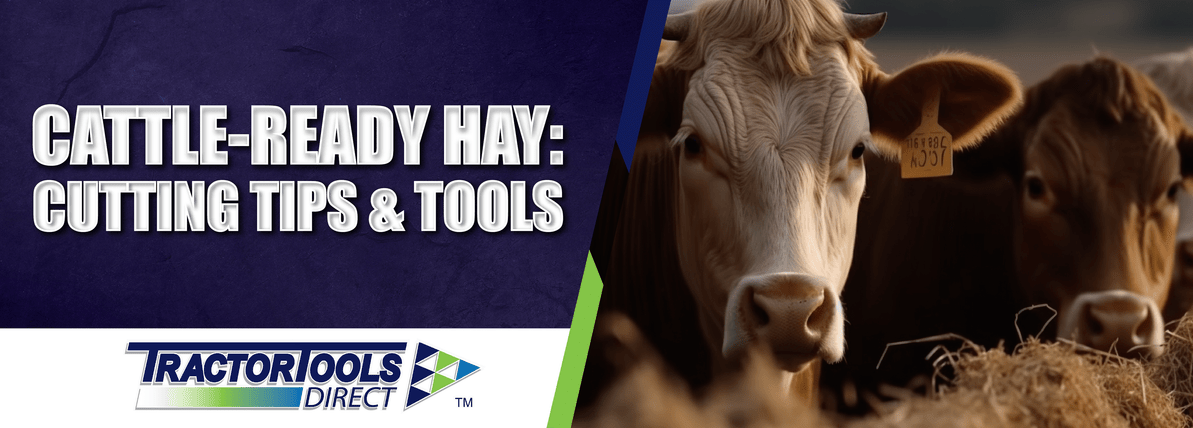Cattle-Ready Hay: Cutting Tips & Tools
Not all hay is created equal–especially when you’re feeding cattle. Unlike horses, cows can tolerate coarser hay, but they still need properly timed, nutritious forage to support health and production. Whether you’re raising beef or dairy cattle, knowing when to cut and what tools to use is key to making hay that’s both palatable and cost-effective.
When to Cut: The Boot Stage Advantage
For cattle, hay should ideally be cut during the boot stage–just before the seed head emerges. At this point, grasses like orchardgrass, fescue, or timothy offer maximum protein and digestibility, which is especially important for lactating cows. Waiting too long leads to overly mature, fibrous hay that’s harder to digest and less nutritious. Timing also impacts yield. Our blog on When to Cut: A Guide to Timing Your Hay Harvest explains how to balance cutting time with regrowth potential for multiple harvests per season.
Hay for Cows vs. Horses
Horse hay typically requires finer texture, no dust or mold, and high leaf retention. Cattle, on the other hand, can thrive on slightly more mature hay, especially if it’s baled properly. This means you can cut slightly later to increase yield, as long as the hay remains clean and well-preserved. That said, poor-quality or late-cut hay will lead to increased waste and lower feed efficiency. Using the right tools help keep forage clean, uniform, and easier for cows to consume.
Tools That Help You Cut Right
Start with a mower that delivers a smooth, even cut–like our drum mower. Blade sharpness also matters–torn or crushed stems slow drying and reduce quality. Our drum mowers have excellent blades that stay sharp for extended periods and long-term use. Once cut, use one of our hay tedders to flip windrows, accelerating drying and reducing spoilage–a key step when making hay for cattle who may tolerate coarser texture but not mold.
Final Thoughts: Cattle-Ready Hay
Cutting hay for cows isn’t just about volume–it’s about timing and nutrition. Choosing the right stage for cutting, understanding your animals’ needs, and using the right equipment can make a big difference in both feed value and efficiency. Want more tips? Read our blog on Tips for Storing Hay to make sure your hard earned forage lasts all season long.
For more information visit www.tractortoolsdirect.com or give us a call at 260-BALE-HAY–we would love to chat!
FAQs
When is the best time to cut hay for cows?
The best time to cut hay for cattle is during the boot stage, just before seed heads appear. This ensures high nutritional value and better digestibility.
What is the difference between hay for cows and hay for horses?
Hay for horses needs to be finer, cleaner, and lower in dust. Cows can handle more mature, coarser hay as long as it’s properly dried and free of mold.
Can cows eat late-cut hay?
Yes, cows can eat late-cut hay, but it will have lower protein and digestibility, which may lead to more waste and reduced feed efficiency.
What kind of mower is best for cutting hay for cattle?
We highly recommend our drum mower for all hay cutting due it’s clean, even cuts that preserve forage quality.
How do I know if my hay mower blades need sharpening?
If the blades leave ragged cuts or tear the grass instead of slicing cleanly, they likely need sharpening. Regular maintenance helps improve hay quality and drying time.
Why is it important to dry hay quickly after cutting?
Quick, even drying prevents mold and nutrient loss, both of which can lower hay quality and make it less safe for cattle to eat.
How can I speed up hay drying after cutting?
Use a tool like a hay tedder to fluff and turn windrows, allowing better air circulation and faster drying.
Recent Posts
-
Best Front Loader Attachments for Your Kubota BX Series Tractor
If you own a Kubota BX-series compact tractor, you already know it’s a versatile machine — but p …Dec 30th 2025 -
Boost Pine Straw Production Efficiency with Ibex Mini Round Balers
At Tractor Tools Direct, we're known for our high-quality hay equipment tailored for small farms …Dec 8th 2025 -
How to Winterize Your Tractor: Essential Maintenance Tips to Protect Your Investment
Farm equipment is one of the most valuable investments a farmer can make. At Tractor Tools Direc …Dec 1st 2025




